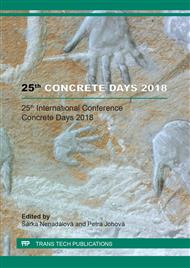[1]
T. Gries, Textiles (Report rep036 : Textile Reinforced Concrete - State-of-the-Art Report of RILEM TC 201-TRC),, v Textile Reinforced Concrete - State-of-the-Art Report of RILEM TC 201-TRC, (2006).
DOI: 10.1617/2351580087.037
Google Scholar
[2]
T. Bittner, P. Bouška, M. Kostelecká, a M. Vokáč, Experimental Investigation of Mechanical Properties of Textile Glass Reinforcement,, in Applied Mechanics and Materials, 2015, roč. 732, s. 45–48.
DOI: 10.4028/www.scientific.net/amm.732.45
Google Scholar
[3]
P. Reiterman, M. Jogl, V. Baumelt, a J. Seifrt, Development and Mix Design of HPC and UHPFRC.,, Adv. Mater. Res., roč. 982, (2014).
DOI: 10.4028/www.scientific.net/amr.982.130
Google Scholar
[4]
D. Pryl a J. Červenka, ATENA Program Documentation Part 11 - Troubleshooting Manual,, pp.20-21, březen (2018).
Google Scholar
[5]
A. Chira, T. Vlach, L. Laiblová, C. Fiala a tým, Comparison of different methods for determination of modulus of elasticity of composite reinforcement produced from roving, Praha, (2014).
DOI: 10.4028/www.scientific.net/amr.1054.104
Google Scholar
[6]
T. Vlach, Soft insert for support modeling of slightly textile reinforced concrete,, Leden (2018).
Google Scholar
[7]
B. Banholzer, BOND BEHAVIOUR OF A MULTI-FILAMENT YARN EMBEDDED, Aachen, (2004).
Google Scholar
[8]
T. Vlach, M. Novotná, C. Fiala, L. Laiblová a P. Hájek, Cohesion of Composite Reinforcement Produced from Rovings with High Performance Concrete,, Applied Mechanics and Materials, pp.397-402, (2015).
DOI: 10.4028/www.scientific.net/amm.732.397
Google Scholar
[9]
T. Vlach, L. Laiblová, M. Žaníšek, A. Chira, A. Kumar a P. Hájek, The Effect of Surface Treatments of Textile Reinforcement on Mechanical Parameters of HPC Facade Elements,, Key Engineering Materials, pp.203-206, (2016).
DOI: 10.4028/www.scientific.net/kem.677.203
Google Scholar
[10]
S. Gopinath, N. Iyer a R. Gettu, Finite element analysis of RC beams strenthened with textile reinforced concrete,, Journal of Structural Enginering, sv. 5, č. 43, pp.454-460, (2016).
Google Scholar
[11]
J. Žalský, Numerická analýza rámového rohu vyztuženého textilní uhlíkovou výztuží,, Bakalářská práce (Bc.), p. přílohy, 2018-27-6.
Google Scholar


